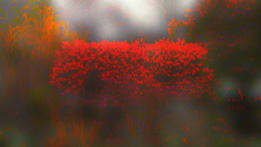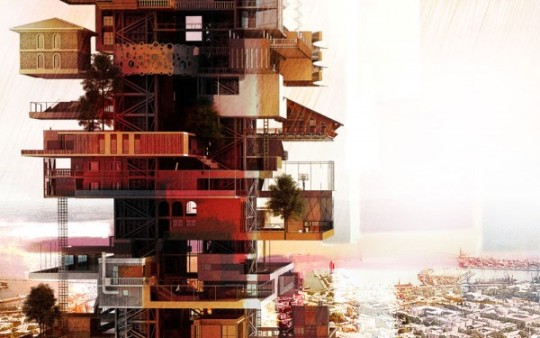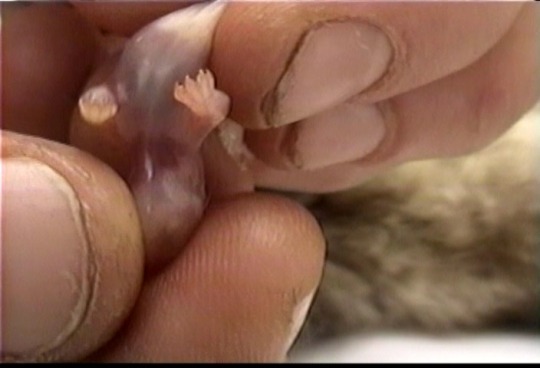Experimental cinema from the prospective of a wannabe. Response to the film's viewed through Binghamton University's Cinema Dept Film Salon & Visiting Artist programs.
Don't wanna be here? Send us removal request.
Text
Yes We Can!
I always find it intriguing when a filmmaker uses found footage and plays with the clip. The filmmaker makes choices on purpose to convey a certain message about the clip. It is interesting to figure out what that message is and how editing choices help to carry the message across.
This is exactly what Alexander Dupuis did in this 5 minute video.
Using a clip of President Obama uttering his well known campaign slogan "Yes We Can", Dupuis plays with the footage to communicate the idea of a phrase that was originally used to instill hope, lost its value thanks to constant repetition. Dupuis presented this by looping the footage. Dupuis also played with the actual image, distorting it to the point that it started to look as if it was melting. It represents the almost melting effect repeating information can happen on a person. Sort of like brainwashing.
Another film created on computer, it was different way of looking at how the value of words can depreciate over time thanks to repetition.
0 notes
Text
Void Two
This was video by Alexander Dupuis from Dartmouth College.
I have to admit, I was in awe watching this film, couldn't take my eyes off the screen. It just amazed me what one can create using computer. Only a 5 minute video, but I can only imagine how long the tedious task of creating the video was.
It was so intriguing to watch. It seemed as if the actual screen was talking. Reminded me of something straight from a Science Fiction or Horror movie. The texture was not only in the visual of the silver spinning object, but also in the score, with the raspy-ness and jaggedness in the "voice" and it going in and out. This helped to create the effect of a voice talking.
The pace also helped in the viewing pleasure, slow build up to the explosion of the visual moving faster and sounds of the "voice" getting louder, phones ringing and an engineer roaring.
Just for it to suddenly stop. Was almost waiting for something scary to pop up.
3 notes
·
View notes
Text
Addiction Obsession
This was a 3 minute long 16mm film done by Catie Eller, from the San Francisco Art Institute.
The film gave me the feeling of indulging in something so wrong for you but feels so right. It was a feeling a being trapped, with moments of light clouded by bad judgement. It seems as if Eller scratched the actual film, a technique I learned in one of my cinema classes. What I liked is that each scratched looked very deliberate as it helped to providing the feeling of being lost. There were moments of light that were quickly overpowered by dark color of the film.
As a silent film, it help lend to the idea of suffering with an addiction or obsession is a personal battle. So the scratches can also be seen as thoughts that races through one's mind.
Looking at the film was like looking a reflection of my mind at any given moment.
0 notes
Text
This past weekend was the Student Experimental Film Festival, which was organized by Binghamton University students. It was a showcase of films by college students around the country. Starting from Friday night, the festival had four showings, each centered around a particular theme. Unfortunately I was only able to catch the last showing on Saturday evening. The theme was "The procession of textual abstraction", which each film having putting an emphasize on capturing textures. There were three films that really captured my attention. Can honestly say I left there inspired, ready to grab my camera and film.
0 notes
Link
TRYPPS 6 (except), Ben Russell
[can also find excerpts from his other works.]
0 notes
Text
The Beat of the Film
The fourth installment of the Visiting Artist series was filmmaker Ben Russell.
From the beginning, Russell grabbed my attention, having an upbeat vibe that carried through out his presentation. Of all the filmmakers, he spoke with the most passion, in my opinion, as he explained the inspiration to his "TRYPPS" series.
A fan of the punk rock scene and of experimental music, Russell wanted to convey that same energy and experience of indulging in the music genres through his films. He managed to translate his inspiration by making sure each piece had a rhythm that resembled that of the genres.
In his piece titled TRYPPS 3, Russell filmed an audience at a Punk concert in Rhode Island. Concentrating on the spectator's experience, it was filmed as if someone was shining a flashlight into the audience. Russell was able to achieve close ups of fans reactions, while still lending to the fact that they were part of a larger crowd. As the concert progressed, the energy became more intense. The actual music became distorted and it seemed as if the audience was now in a trance. High off the music, overdosing on the adrenaline of the performance.
Another piece from the series I was particularly fond of was titled TRYPPS 6. It was a depiction of a gathering in a Suriname village. The center of attention was six men dressed up in Halloween type costumes, dancing to music of other villagers. Keeping with his inspiration, Russell kept a steady pace as he followed the "performers" to their "stage". This steady pace lead up to the big ending of the entertainers breaking out into a style of dance that resembled the rockers of the previous film mentioned.
What was enjoyable about these 2 films was while they were shot in an ethnography style, there was still a creative element. Russell showed other works that were more on the "experimental" side, but I saw these two as more creative. Rather than be straight forward, Russell crafted it so the audience was part of the action. The viewers were able to rock out along side the people in the film.
0 notes
Video
youtube
Ben Russell's Black and White TRYPPS Number 3
0 notes
Text
Nature v. The Machine
The third installment of the Visiting Artist series was a presentation from Binghamton University's own Professor Vincent Grenier. I've had the chance to take a class taught by Professor Grenier and signed up to take another next semester. It was also in his class that I encountered the most bizarre but interestingly pleasing film pieces.
Not providing much of an introduction, Professor Grenier dove right into showing his pieces. there seem to be this underline theme of nature in each of the films presented. Particularly, ways of manipulating one's view of nature.
For example, in the 2nd film entitled "Burning Bush", Grenier created an image of a burning bush by playing with the focus. Distorting the view, replicating what it looks like when you stare at an object for too long. Bright reds, purples, greens, and yellows meshed together to create a "ball of fire", layered with the sound of crackling, topped with constant zooming in and out to add to the intensity of the burning. And then abruptly end with a regular shot of the bush, in its natural state, no modifications and the soundtrack of birds and wind.
I took Grenier's presentation as a lesson on the ways you can create images within the camera and in post-production. The same way a painter can create art on canvas, a filmmaker can create art through the camera, literally. Any still from any of his films could easily become art work in a gallery or your sweet grandma's home.
I really liked the 6th film he showed. Going along with the nature theme, Grenier filmed the scenery during a bus trip. Though the focus was the trees and the grass outside the window, there was a reflection of the other side of the bus in the shot. Also you could hear the rumbling of the bus and conversations of passengers as oppose to the wind. I enjoyed the Natural versus Man-Made element:
Enjoying something natural through the point of view of a man-made instrument (the camera). Enjoying something natural while sitting on a man made object (the bus). Enjoying something natural while driving along a man made construction that interrupted nature (the highway).
2 notes
·
View notes
Photo

Still from Burning Bush, one of the films shown during visiting artist, Vincent Grenier's presentation.
0 notes
Photo

vertical street/city by Sergiy Prokof`yev, Arsenii Kuznetsov, Oleksandr Garashchenko / via evolo
9K notes
·
View notes
Text
Beauty and the Dead
This week's Visiting Artist was Dani Leventhal. Originally from Columbus, OH, now lives and works in Brooklyn, NY. While Leventhal did not provide much of an introduction, it is safe to say her work did not need one. The films spoke for themselves, in loud, sometimes uncomfortable volumes.
Leventhal showed a total of five films. The first one immediately captured my attention. Titled Draft 9, it was the longest of the five and the hardest to stomach, literally.
"What the fuck?!", head scratching, and the "O_o" face were my continuous reactions as I watched. Constant shots of animal skinning, animal caucuses, and a particular shot of dead possum fetuses, made me say "ewww" a number of times. Even the close up shots of the old woman was a bit bothersome.
Leventhal explained that she developed a fascination after learning how to skin animals when she was younger. She became intrigued by the anatomy of animals, and would pick up dead ones to study their insides.
But I must admit that Leventhal made her point very clear. A gross depiction of the circle of life, and the ways life and death coexist. The images of dead animals were contrasted with images of Leventhal, her family and friends performing seemingly normal, everyday behavior. A 3D collage of the living and the dead.
I enjoyed the continuity throughout the film. It helped to create order in the awkward chaos. I also liked that Leventhal uses a small Canon HD camera and iMovie to edit her videos. No fancy equipment needed to express her ideas.
But then again, if the films are a reflection of life, all one would need is your typical home video camera.
0 notes
Photo

Frame film Draft 9, one of five films Visiting Artist Dani Leventhal presented.
0 notes